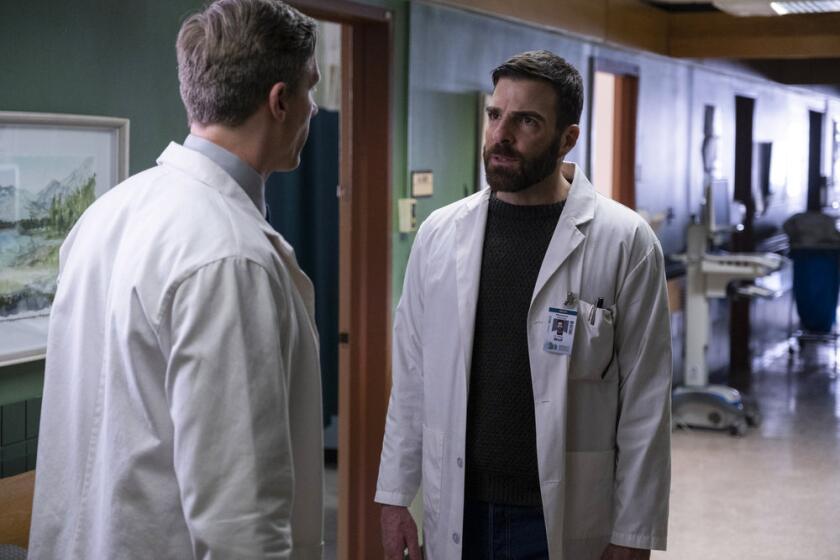Science theories mixed with creativity prove popular on YouTube
Eli Cirino’s high school science project was quite literally an overnight success.
Students in the 10th-grader’s honors chemistry class at Granada Hills Charter High School were asked to make a video illustrating a scientific concept, so Eli chose ionic bonds. After finishing his project — a combination of music, live action romance and animation titled “Good Chemistry” — and uploading it to YouTube, Eli told a few friends and posted the link to Reddit. The video began to rack up a respectable number of hits — when he went to bed that night, it was at 300.
The next morning, Eli received an excited text from his co-star: Their project had shot up to 62,000 hits. The numbers kept climbing, and by week’s end reached more than 300,000 views. Not bad for an extra-credit project that took only two days to create.
VIDEOS: Five YouTube videos that mix science with fun
This impressive response to a well-executed but relatively modest project is evidence of how quickly any online video that successfully fuses the scientific with the approachable can win an appreciative audience. Science especially suffers from an unfun reputation: an emotionless discipline practiced by exacting, white-coated brainiacs. Given that recasting the serious with the silly is a classic comedy formula, combined with the number of science teachers eager for ways to reach intimidated students and the general dearth of high-level thinking on YouTube, there’s an underserved audience of science-minded viewers.
“The PCR Song” is another case in point. While PCR — or polymerase chain reaction, a technology used to copy DNA sequences — isn’t a topic that would seem to draw a huge fan base, the slickly produced YouTube parody, created by instrument company Bio-Rad and featuring faux rock stars singing the technology’s praises, racked up well over a million views — many of them biotech students reveling in the joy of a joke made just for them.
Natalia Blank, a chemistry professor at Norwich University in Vermont, uses “PCR Song” in her Introduction to Forensic Science. Blank plays the clip, she says, “to provide a little comic relief and an emotional connection to the otherwise dryish science lecture.” If she hears students leave class singing, “PCR, it’s the way to detect mutations…,” she says they’re more likely to remember the overall concepts.
Another instant classic of the genre is “Chemical Party,” in which actors portray chemical elements to illustrate, among other concepts, hydrogen’s attraction to carbon with two actors who lustfully latch on to each other. As the party continues to a thumping electronica beat, guests flirt (hydrochloride and zinc), fight (water and potassium) and break up (sodium and chlorine, with the help of jumpsuit-wearing electricity). Made by the European Commission to promote a research grant program, the clip also joined the million-plus club and has inspired dozens of low-budget homages.
Being crowd-sourced, YouTube has plenty of poor to middling attempts at scientific humor — awkward “gangsta” raps set in bio labs, tedious baking soda and vinegar skits — but performers who master the art of egghead appeal can rise to the top. The L.A.-based duo of Chris Hardwick and Mike Phirman, who perform under the name Hard ‘n’ Phirm, made their name by crafting tunes such as “Trace Elements,” a salty country twanger that name-drops nearly every scientific concept known to man (“Sub-string theories, hypotheses, argon laser, Occam’s Razor”) sung in a pickup truck, and “Pi,” whose chorus is the recitation of pi to about 50 decimal places, with visuals that riff on the ‘70s PBS kids’ show “Zoom.” And of particular appeal to anatomy students, “El Corazon,” sung entirely in Spanish, is a passionate ballad crooning about the heart’s function in the circulatory system.
Using music videos to make complex topics more inviting to students dates well before the “Schoolhouse Rock” era, but even the noble pursuit of education can take artists on unplanned excursions.
“When I was growing up, science was as American as apple pie,” says John Flansburgh of alt-rock band They Might Be Giants, recalling the age when space exploration held a firm grasp on the American imagination and James Bond movies always featured a scientist whose job was to provide 007 with super-cool gizmos. But in a shift that Flansburgh traces to theGeorge W. Bush era, which introduced a climate of skepticism and even hostility toward science, “there really is this culture war in which to talk about science in public as if it holds actual truths is a very risky position to take.”
Flansburgh and partner John Linnell became giants in the educational music video world when they launched a parallel career in children’s music, bringing their infallibly catchy songwriting to a series of DVDs, including 2009’s “Here Comes Science.” The duo, originally from Lincoln, Mass., didn’t set out to produce anything remotely contentious, Flansburgh says — “the songs are dealing with topics you were taught in school — gravity, DNA, space travel, photosynthesis.” Yet the introductory track, “Science Is Real,” which contains the lyric “The proof is with science, the truth is with science,” generated 157 pages of argumentative and vitriolic comments on YouTube, of which Flansburgh quips, “YouTube comments are no place to go if you want to feel better about society.”
Arguments aside, “Here Comes Science” was nominated for a Grammy and has become a classroom favorite for its whimsical take on topics such as evolution, archaeology and the scientific method. The videos are often used as assigned viewing by teachers, which, Flansburgh says, “is strange, because we were terrible students. We don’t see ourselves as educators — it was very much about entertainment.” The band did employ a scientific consultant, but the available body of work suggests that it’s far easier for an artist to write an entertaining yet scientifically accurate song than for a scientist to write a song that’s scientifically accurate yet entertaining.
The stereotype of the scientist as mired in the incomprehensible has more than a grain of truth, but that lack of comprehension is the gap that the Center for Communicating Science at New York’s Stony Brook University sought to bridge with its “Flame Challenge” contest. The center’s high-profile co-founder, actor Alan Alda, explains his long-standing interest in “trying to show the human side of scientists — they’re not alien creatures talking a foreign language.” Alda pauses. “Well, sometimes they do talk a foreign language — but we can fix that.”
The center, which works to enhance scientists’ communication skills, sponsored the contest inspired by Alda’s recollection of being 11 years old and asking a teacher what a flame was. The teacher’s unsatisfying, one-word answer, “oxidation,” led to a challenge to create a better answer, and students of that age group from around the world were invited to participate as judges.
The students, Alda says, absolutely picked the best entry — and not only for its entertainment value. “Surprisingly, the most common complaint was that many entries didn’t give them enough information — they really want to learn. They are interested in its being entertaining, but they don’t want it to be silly, and they don’t want it to talk down to them.”
The winning entry, a video made by Ben Ames, a grad student at the University of Innsbruck, Austria, explains the concepts of pyrolysis, chemiluminescence and oxidation with an animated sequence featuring a bearded man shackled in the dungeons of hell, contemplating a burning candle in a pink cupcake as flames erupt around him.
Part of what makes Ames’ video successful is that he doesn’t try to squeeze every bit of information into a song. Ames explains the concepts in an illustrated lecture and then ends with a song that underscores them.
Eli Cirino ran into a similar challenge when creating his song, which, despite hefty YouTube page views, earned just a C. While Eli’s original music was polished, his teacher criticized it as light on content — an allegation Eli admits to. But he protests, “If I had all of that information in there, it wouldn’t have been as good of a video.”
And thus, a hard truth was learned: Ultimately, science is about facts first and fun second.
More to Read
The complete guide to home viewing
Get Screen Gab for everything about the TV shows and streaming movies everyone’s talking about.
You may occasionally receive promotional content from the Los Angeles Times.






